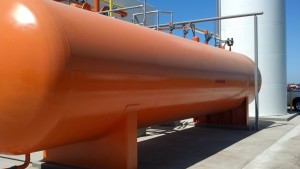Notifying Personnel of Ammonia Delivery
ANSI/IIAR 5-2013 Start-Up and Commissioning of a Closed-Circuit Ammonia Refrigeration Systems outlines the “basic minimum requirements for the safe start-up and commissioning” of ammonia refrigeration systems. One of the critical requirements contained within this document is that facility personnel be notified prior to ammonia being delivered onsite.
ANSI/IIAR 5-2013 §7.8.4
Notice shall be given to ensure that all personnel on the site are aware that the system is about to be charged with ammonia and that the area in which the machinery room and charging equipment is located will become an area closed to unauthorized persons.
There are certainly many options available to meet the spirit and intent of this requirement. Meetings, verbal announcements, emails, etc. are all viable options for communicating to personnel that ammonia will be delivered onsite. Regardless of the method chosen to communicate to personnel, ensure that you document the communication in a way that clearly demonstrates your actions. The following Notice of Ammonia Delivery may serve as a helpful template to achieve that end.
NOTICE
Pursuant to ANSI/IIAR 5-2013 §7.8.4 Company XYZ is providing this notice to all personnel onsite that ammonia will be added to the refrigeration system. Ammonia is scheduled to be delivered on _________ at approximately ________pm. The ammonia refrigeration machinery room and charging equipment will become a closed area during that time and must not be accessed unless approval is given by Company XYZ management.
Physical Description
Anhydrous ammonia is a clear, colorless gas with a characteristic intensely irritating odor. As a substance, ammonia has a high affinity to water. Due to the low boiling point of ammonia (-28°F), spills or leaks that occur at Company XYZ will tend to generate ammonia gas. Liquid ammonia spills or leaks will result in rapid evaporation which is known as a “cloud” of ammonia. Ammonia “clouds” are extremely dangerous and should be treated with extreme caution. Ammonia vapor causes immediate irritation of the eyes and respiratory tract. High concentrations cause conjunctivitis, laryngitis, and pulmonary edema, possibly accompanied by feeling of suffocation. Skin contact cause chemical burns, blistering, and frost bite.
Exposure Limits
- ACGIH has set an 8-hour TWA of 25 ppm. Cal/OSHA’s PEL for ammonia is also 25 ppm
- ACGIH and OSHA have a 15 minute TWA (STEL) of 35 ppm
- The lower explosion limit (LEL) by percent volume in air is 15% and the upper explosion limit (UEL) is 28%
- NIOSH recognizes 300 ppm as the concentration that is immediately dangerous to life and health (IDLH)
Emergency and First-Aid Procedures
Eyes
- Flush with large quantities of water for at least 15 minutes.
- Seek medical aid.
Skin
- Immediately flush with large quantities of water for at least 15 minutes. Do not remove clothing if frozen to skin.
- Seek medical aid.
Inhalation
- Remove from exposure; seek fresh air.
- Administer artificial respiration or oxygen if breathing has stopped.
- Seek medical aid.
Ingestion
- Do not induce vomiting. Give 1-2 glasses of milk or water.
- Seek medical aid.
For more information on the dangers of anhydrous ammonia refer to the SDS, hazard communication program, and RMP/PSM/CalARP program.
Other References
If you have questions about this notice, please contact:
John Doe, EHS Manager
(xxx) xxx-xxxx


Leave a Reply